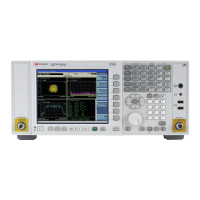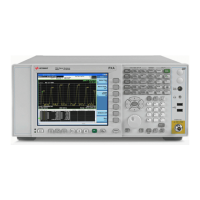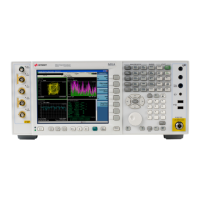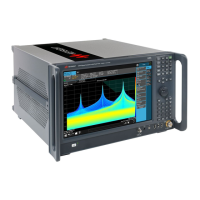306 Chapter 15
Functional Tests
Frequency Response (Flatness)
8. On the signal analyzer, press Single.
9. Press the
Peak Search key on the signal analyzer to position the marker on the
peak of the signal.
10. Refer to Table 15-6, “Frequency Response (Flatness) Results.” Enter the
amplitude of the signal displayed on the signal analyzer into the Meas
Amp
column of Table 15-6.
11. Enter the power meter reading into the Power
Meter
column of Table 15-6.
12. Tune the synthesized sweeper and signal analyzer to the next frequency listed
in Table 15-6.
13. Enter the power sensor calibration factor into the power meter.
14. For frequencies 3.6 GHz and above, press
AMPTD Y Scale, then Presel
Center
to center the preselector filter for an optimum amplitude measurement.
15. Repeat step 7 through step 14 and complete the remainder of Table 15-6 for the
frequency range of your analyzer.
16. Compute the measurement error (Meas
Error
= Meas
Amp
− Power
Meter
).
17. Compute the flatness error normalized to 50 MHz:
(Meas
Error
− Meas
Error
@ 50 MHz)
18. Enter the computed flatness error value into the Flat
Norm
column of Table 15-6.
19.Compare the value of Flat
Norm
to the test limit.
Table 15-6 Frequency Response (Flatness) Results
Center
Frequency
Analyzer
Amplitude
Meas
amp
Power Meter
Measurement
Power
meter
Meas Error
Meas
error
Flatness
Normalized
to 50 MHz
Flat
Norm
Flatness Error
Test Limits
(dB)
50 MHz 0Ref
1 GHz ±1.5 dB
2 GHz ±1.5 dB
3 GHz ±1.5 dB
3.5 GHz ±1.5 dB
4 GHz ±2.5 dB
6 GHz ±2.5 dB
7 GHz ±2.5 dB

